Alaska, a land of magnificent natural wonders, always holds countless surprises waiting for visitors to explore. Amidst majestic mountain ranges and vast forests, Prince William Sound emerges like a sparkling sapphire, captivating anyone who sets foot here. This place not only possesses the pristine, majestic beauty of nature but is also a living museum of indigenous history and culture, promising an emotional journey of discovery and memorable experiences.
Where is Prince William Sound Located?
Prince William Sound is situated in Southcentral Alaska, within the vast Arctic region and just east of the renowned Kenai Peninsula. Spanning over 10,000 km², this sound is like a watery maze with countless small islands, narrow bays, and intricate channels. Surrounding the sound are snow-capped mountains year-round, creating a majestic natural wall to the east and northwest. To the south, the sound opens to the immense Pacific Ocean, creating a unique intersection between mountains and sea.
The land around Prince William Sound is covered by rich vegetation, mainly primeval rainforests and a dense network of rivers. Among them, the Copper River stands out as an important artery, playing a vital role in the ecosystem and life of the area. The sound is not entirely deserted but still has scattered settlements, including small towns like Cordova and Whittier, along with the Alaskan Native villages of Chenega and Tatitlek, communities deeply rooted in traditional culture.
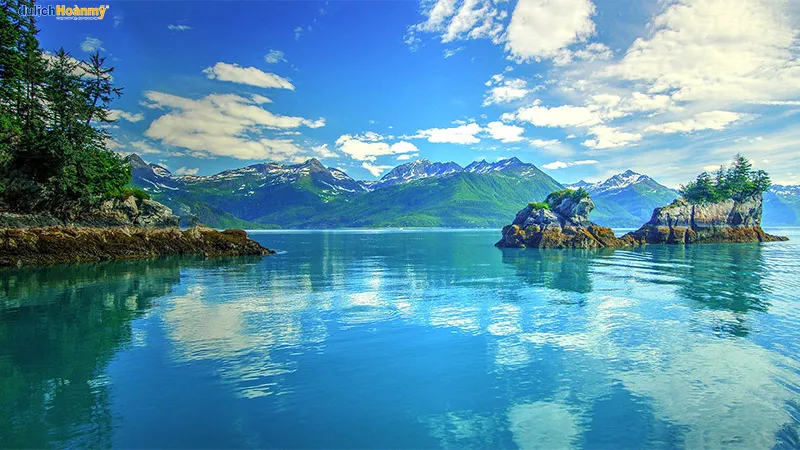
Much of the land surrounding Prince William Sound belongs to the Chugach National Forest, the second-largest national forest in the United States, a testament to the richness and biodiversity of this region. The sound is embraced by the imposing Chugach Mountains, with their steep slopes and magnificent glaciers. The coastline of Prince William Sound meanders gently, forming countless small bays, narrow straits, and especially unique tidewater glaciers, where ice melts directly into the sea. Large barrier islands like Montague, Hinchinbrook, and Hawkins act as natural shields, protecting the sound from large ocean waves.
History of Formation and Milestones Through Time
The formation journey of Prince William Sound is a story spanning millions of years, etched by the extraordinary power of glaciers. During the Ice Age, thick layers of ice slid through this area, eroding and creating deep valleys and vast basins. As the ice melted, it left behind countless ice particles, rocks, and sediments, gradually forming the seabed, limestone arches, and myriad islands of all sizes. The uplift process of tectonic plates also played a crucial role, pushing the seabed upwards, forming land and the diverse islands as they are today.
Throughout history, Prince William Sound was once inhabited by the Alutiiq, Eyak, and Tlingit Native tribes. They were the first inhabitants to explore and exploit the rich resources of this land, living in harmony with nature and developing unique cultures. European footsteps first touched this land in 1778 when British explorer James Cook named the sound in honor of Prince William Henry, son of King George III. However, prior to that, in 1774, Spanish clergyman Juan Pérez had reached the area, marking the earliest European presence. Subsequently, Prince William Sound gradually became a destination for many explorers, hunters, traders, and fishermen seeking opportunities from abundant natural resources such as gold, silver, and seafood.
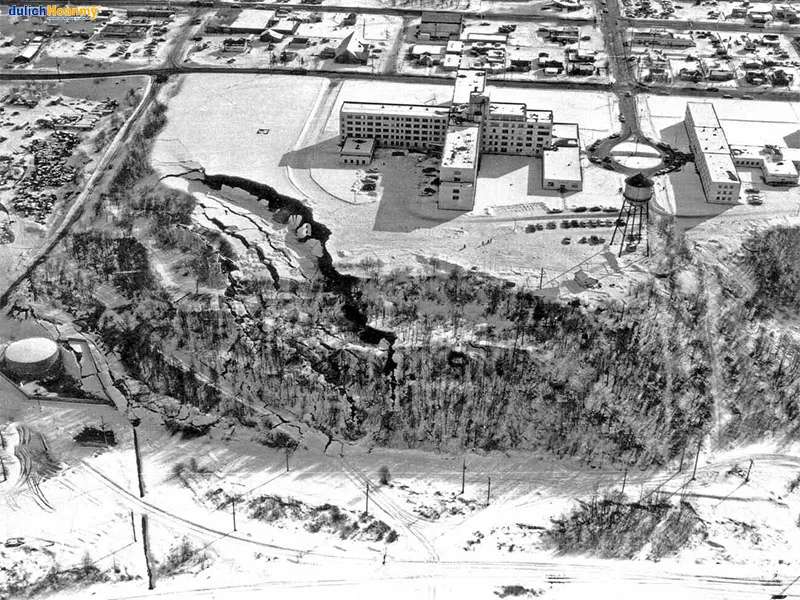
In 1964, Prince William Sound suffered a devastating natural disaster, the strongest earthquake ever recorded in United States history, with a magnitude of 9.2 on the Richter scale. This earthquake triggered a massive tsunami and a series of landslides, claiming many lives and causing severe damage to infrastructure and the lives of people in the area. Nevertheless, the people of Alaska resiliently overcame the difficulties, rebuilt their homeland, and continued to develop Prince William Sound.
However, another tragedy struck in 1989, the Exxon Valdez oil spill, one of the worst environmental disasters in US history. The giant oil tanker struck Bligh Reef, spilling over 40 million liters of crude oil into the sea, causing serious pollution to the marine ecosystem and severely impacting the area’s fishing industry. This disaster sounded an alarm about environmental protection and the necessity of maritime safety measures.
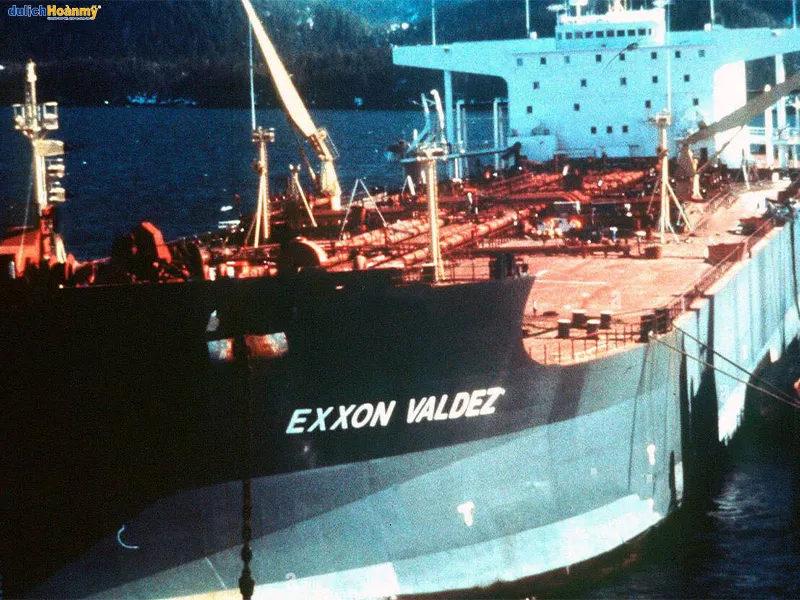
Despite experiencing historical events and natural disasters, Prince William Sound has shown incredible resilience. Today, it has regained its pristine beauty and continues to be an attractive tourist destination, drawing visitors with its unique natural landscapes, rich marine biodiversity, especially rare wildlife species such as whales, seals, sea otters, and seabirds.
Read more: Alaska Tours
Majestic Natural Beauty and Diverse Ecology
Prince William Sound is a vibrant natural painting, created by the wonderful harmony of mountains, forests, and sea. The topography here is extremely diverse, from green islands undulating on the sea surface, majestic vertical cliffs, long stretches of pristine beaches to magnificent glaciers flowing down from high mountains. This region is famous for its spectacular natural scenery, especially the vast primeval forests, the towering Chugach Mountains covered in snow all year round, and countless waterfalls and clear springs.
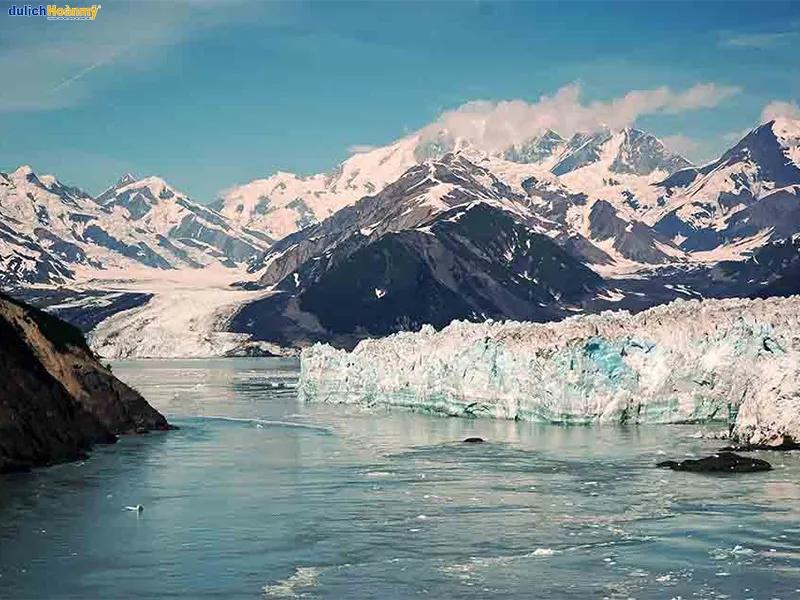
A journey to explore Prince William Sound will take visitors into a mesmerizing wilderness. Sitting on a yacht, weaving through over 10,000 glaciers, islands, and bays, visitors will have the opportunity to admire unique natural wonders. This place is also a kingdom of wildlife, from giant humpback whales, schools of dolphins playfully swimming, mischievous seals frolicking on ice, to adorable sea otters, majestic sea lions, graceful harbor seals, mysterious black bears, and countless other seabirds. These experiences are sure to leave unforgettable impressions on every visitor’s heart.
Prince William Sound also boasts many outstanding destinations, each with its own unique beauty:
- Montague Island: The second-largest island in Alaska, known as the jewel of Prince William Sound. It is famous for its pristine rocky shores, fine white sand beaches, and diverse wildlife.
- Culross Island: One of the largest islands in the sound, a paradise for seabirds and wildlife. Visitors can explore primeval forests, clear blue lakes, and observe fascinating wildlife.
- Sheridan Lake Trail: For those who love trekking and exploring nature, this trail leads to the beautiful Sheridan Lake, passing through dense forests and majestic rocky mountains.
- Nellie Juan Beach: One of the most beautiful beaches in Prince William Sound, with pristine white sand, clear turquoise water, and a peaceful, tranquil atmosphere.
Discovering the Unique Climate of Prince William Sound
The climate of Prince William Sound is characterized by the subarctic region, cold and humid year-round. Winters are long and harsh, with average temperatures ranging from -2 to 2 degrees Celsius (28 to 36 degrees Fahrenheit). Snowfall is heavy and covers everything, creating a beautiful white landscape. Summers are short and cool, with average temperatures from 10 to 15 degrees Celsius (50 to 59 degrees Fahrenheit), bringing a pleasant atmosphere suitable for outdoor activities.
Rainfall in Prince William Sound is quite high, especially in autumn and winter. Average monthly rainfall ranges from 152 to 406 mm (6 to 16 inches). This sea area is also frequently affected by storms and strong winds from the Arctic Ocean, especially in winter, requiring visitors to prepare carefully and monitor the weather before participating in outdoor activities.
The ideal time to explore Prince William Sound is in the summer, from May to September. During this period, the weather is warmer and more pleasant, suitable for tourism and recreational activities such as island exploration, hiking, fishing, kayaking, and scenic yacht cruises. Tours are also more frequently organized in the summer, offering a variety of options and experiences for visitors.
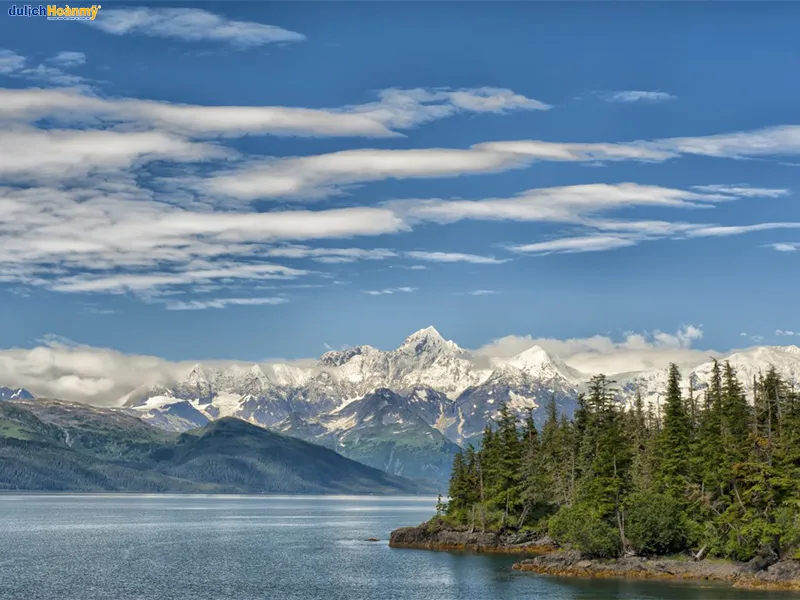
However, if you want to experience the unique beauty of Prince William Sound in winter, you can still join special cruises to admire the snow-covered, pristine, and majestic scenery, as well as observe wildlife adapting to the harsh winter environment. Glacier trekking is also an exciting and adventurous experience in winter.
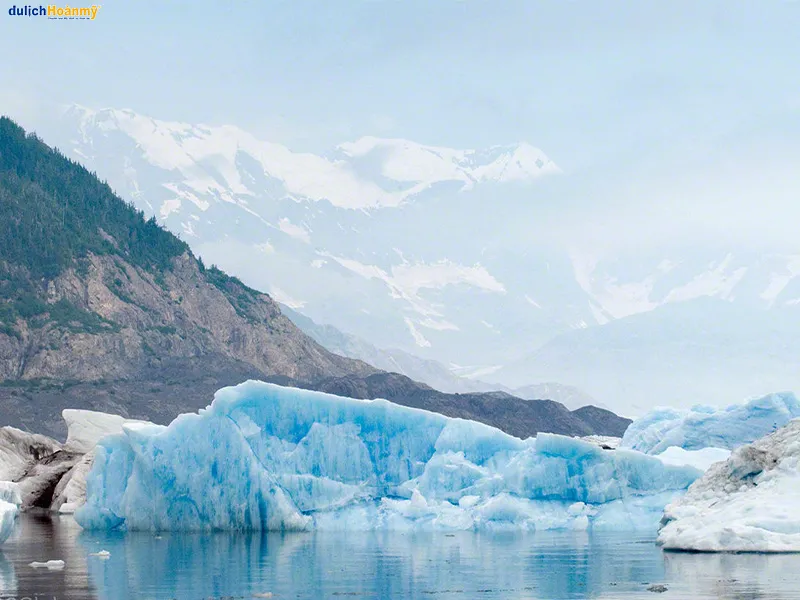
Read more: USA Tours
Directions to Prince William Sound
There are several ways to get to Prince William Sound, depending on your starting point, preferences, and budget. Here are some popular options:
- Car: If you are departing from Anchorage, the largest city in Alaska, you can drive to Whittier, a small town located at the head of Prince William Sound. The distance is about 90 miles (145 km) and takes about 2 hours to drive. This is a scenic drive, passing through beautiful Alaskan landscapes.
- Train: The Alaska Railroad offers train service from Anchorage to Whittier, providing a unique travel experience and stunning views. The train passes through the 2.5-mile-long Anton Anderson Memorial Tunnel, an impressive feat of engineering.
- Cruise Ship: Many cruise lines offer itineraries exploring Prince William Sound, from short day trips to longer voyages. Cruises are an ideal way to explore the beauty of the sound, access remote areas, and view wildlife.
- Floatplane: If you want an adventurous experience and a bird’s-eye view of the sound, you can charter a floatplane. This is a fast and flexible mode of transport, allowing you to reach narrow bays, glaciers, and wilderness areas that are difficult to access by other means.

Unmissable Experiences in Prince William Sound
A journey to explore Prince William Sound will bring you countless memorable experiences, immersing yourself in the wilderness and discovering wonders:
- Scenic Cruises: Joining scenic cruises is the best way to explore the entire Prince William Sound. You will admire majestic glaciers, beautiful narrow bays, green islands, and observe wildlife in their natural habitat.
- Kayaking: Kayaking is a popular and exciting activity in Prince William Sound. You can explore small bays, pristine coastlines, get closer to nature, and enjoy the peaceful, tranquil atmosphere.
- Hiking: Prince William Sound has many hiking trails of varying levels, suitable for all types of visitors. You can explore primeval forests, climb high mountains to admire panoramic views of the sound, and enjoy the fresh air.
- Fishing: Prince William Sound is a fishing paradise with a variety of fish species such as salmon, halibut, cod, etc. You can join fishing tours or experience recreational fishing on the sea yourself.
- Glacier Exploration: Join glacier exploration tours to admire the majestic beauty of giant ice masses, explore ice caves, and learn about the formation and transformation of glaciers.
- Wildlife Viewing: Prince William Sound is home to many rare wildlife species. You can join wildlife viewing tours to see whales, seals, sea otters, seabirds, and many other animals in their natural environment.
- Camping: Experiencing overnight camping at coastal campsites or on islands is a great way to immerse yourself in the wilderness, watch the starry night sky, and enjoy the quiet, peaceful space.

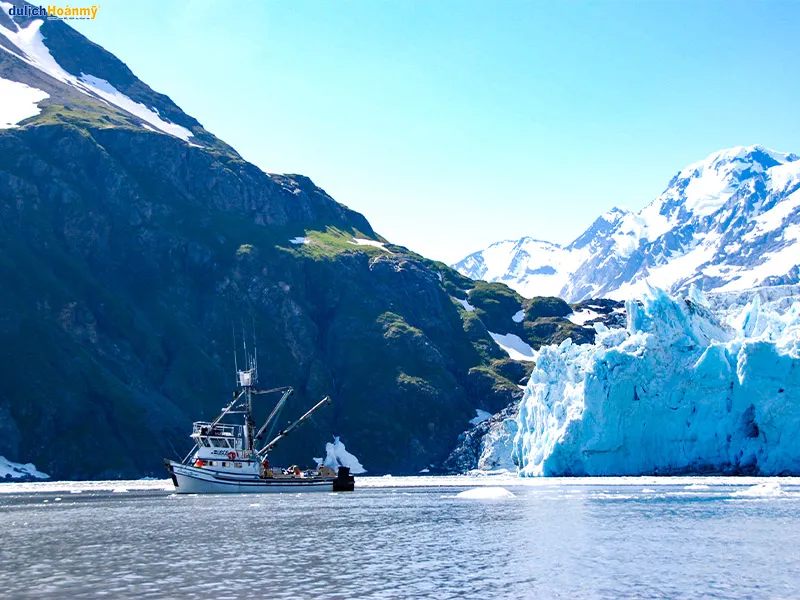
Conclusion: Prince William Sound – A Dream Destination for Every Journey
Prince William Sound is not just a tourist destination, but also an emotional journey of discovery, where visitors can immerse themselves in the wilderness, learn about indigenous history and culture, experience exciting activities, and create memorable memories. With its majestic beauty, ecological diversity, and unique experiences, Prince William Sound deserves to be one of the dream destinations in the journey to explore Alaska and the vast United States. Come and feel the true beauty of nature, the wonders of wildlife, and the warmth of the Alaskan land!